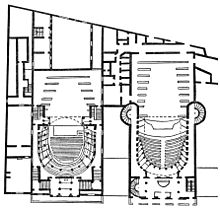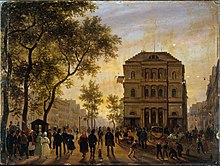Théâtre de l'Ambigu-Comique

The Théâtre de l'Ambigu-Comique was a theater opened on July 9, 1769 on the Boulevard du Temple in Paris with 1,800 seats at the time. It was built by the Cologne architect Jakob Ignaz Hittorff and Nicolas Médard Audinot, who lives in Paris .
founding
Audinot, a former performer of the Opéra-Comique to Charles-Simon Favart , had as a puppeteer at the fairs independently made. He had achieved some success with these performances at the Saint-Germain fair .
When it was founded, Audinot's company was called Comédiens de bois ("wooden comedians"). Because the repertoire of marionettes was expanded to include pantomimes , acrobatics, children's ballets, small plays, vaudevilles and opéras-comiques , a permanent theater was built and the institution was renamed Ambigu-Comique (roughly: "Mixture of comedic theater genres"). The children's ballet in particular was very successful.
Fight against prohibitions

Since Audinot competed with the privileged theaters, he had to contend with bans. In 1771 he was banned from singing and dancing on the stage and from an orchestra with more than four musicians because the theater attracted more audiences than the Paris Opera . After various disputes, Audinot reached an agreement with the opera in 1780 on a license payment so that he could perform a limited range of music-theatrical productions. The Comédie-Française and Théâtre-Italy, on the other hand, insisted on their privilege to control the plays with spoken dialogue.
Despite these difficulties, Audinot managed to enlarge the theater in 1786. Now the fashionable romantic-historical holidays were performed there, such as La Belle au bois dormant ( Sleeping Beauty ), Le Masque de fer , La Forêt-Noire , Le Capitaine Cook . They were pre-forms of melodrama as well as classical ballet . Due to the theater freedom of 1791, many competitors appeared, so that the Ambigu-Comique had to fight for its existence and had to close in 1799. In 1801 the theater became the birthplace of the melodrama of Guilbert de Pixérécourt , Caigniez and Victor Ducange .
New building on Boulevard Saint-Martin
The Ambigu-Comique burned down in 1827 and has now been rebuilt on Boulevard Saint-Martin, the western extension of Boulevard du Temple, and it now stood next to the Théâtre de la Porte Saint-Martin . It flourished there throughout the 19th century with melodramas, vaudevilles and other popular attractions. Here was Prince Florestan I of Monaco hired as an actor (before assuming his government and the public finances with a casino refurbished), and the composer Jacques Offenbach played in the orchestra.
The Théâtre des Folies-Dramatiques was built on the site of the old theater in 1832 . Due to its location, the new Ambigu-Comique was one of the few large theaters to survive the destruction of the Boulevard du Temple through the redesign of the Parisian boulevards under the direction of Georges-Eugène Haussmann .
The 20th century with its new entertainment media led to its decline. In the 1920s, the theater temporarily served as a cinema. In 1954 it was reopened at short notice by the actor Christian Casadesus . They played contemporary playwrights like Roger Vitrac . In 1966 it was closed and demolished despite numerous protests.
literature
- Nicholas Brazier: Histoire des petits théâtres de Paris depuis leur origine , Paris: Allardin 1838
- Jules Bonnassies: Les Spectacles forains et la Comédie Française , Paris: E. Dentu 1875
- Michel Faul, Les Tribulations de Nicolas-Médard Audinot, fondateur du théâtre de l'Ambigu-Comique , Symétrie, Lyon, 2013. ISBN 978-2-914373-97-5 .
